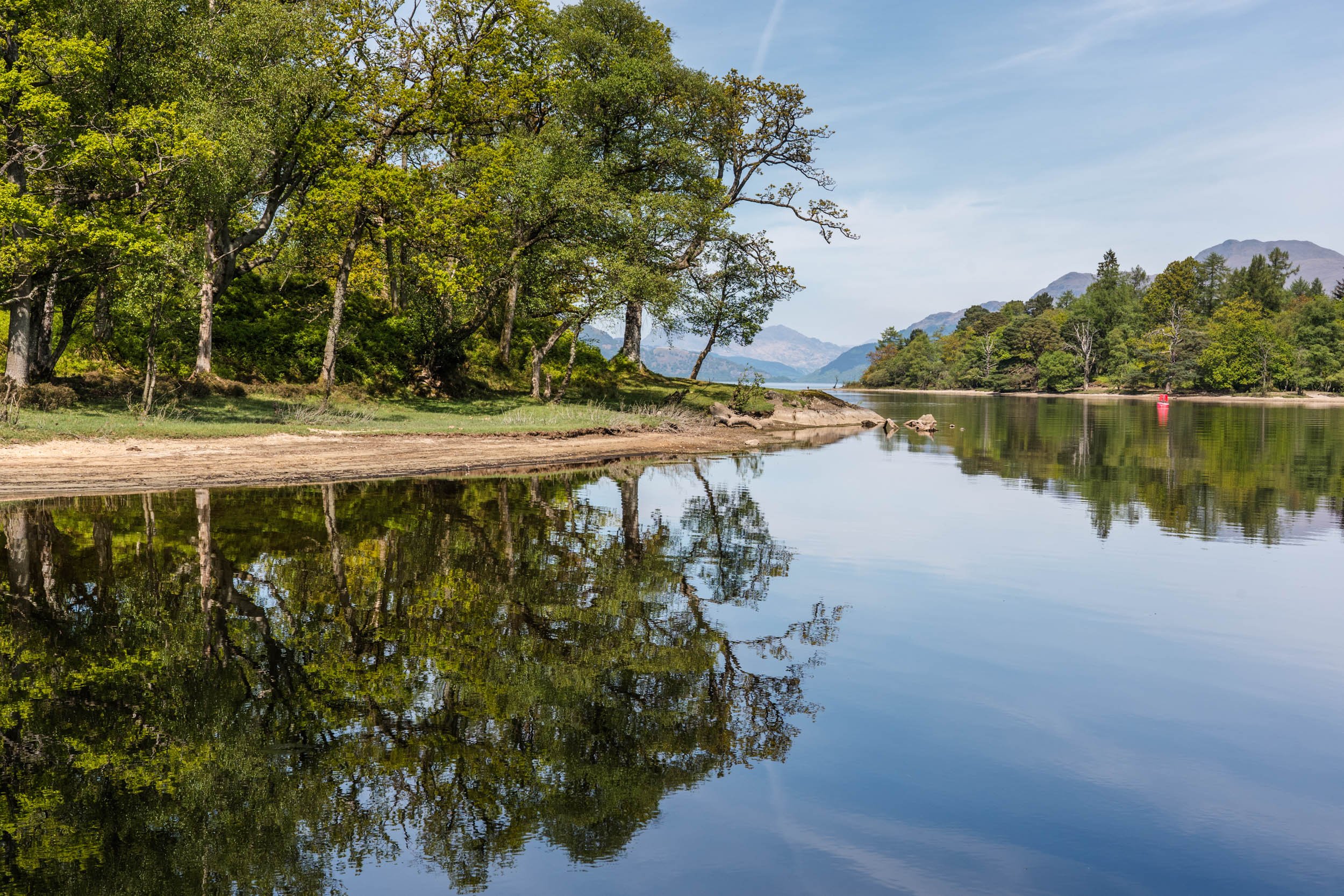
Park Place Names
(Picture: Inchtavanach Island)
The Place Names of Loch Lomond & The Trossachs
Most of the place names around the Loch Lomond and Trossachs area are of Celtic origin; others may be obscure Pictish survivals. Not all authorities agree on derivations, so that some Loch Lomond and Trossachs place names have more than one possible meaning.
Amongst the best-known place names, both Lomond and Trossachs are also obscure (even controversial!). Lomond may be from Gaelic, leamhan, elm, though the more popular explanation is that it is from another Gaelic word laom meaning blaze, hence Ben Lomond - beacon hill (though beacon loch is less satisfactory, unless the loch is named from the hill).
The meaning of The Trossachs has been a popular topic in generations of guidebooks. Dorothy Wordsworth speculated in ‘A Tour in Scotland 1803’: ‘I believe the word Trossachs signifies’ “many hills”: it is a name given to all the eminences at the foot of Loch Ketterine, and about half a mile beyond.’ Sir Walter Scott often spelt the word as ‘Trosachs’ while in ‘Observations on a Tour through the Highlands of Scotland’ by Thomas Garnett, 1800 there is an ‘Account of the Drossacks’. The Rev Patrick Graham –a minister in Aberfoyle - in his ‘Sketches of Perthshire’ (1806) was the first to suggest that the ‘Trosachs’ meant ‘the rough or bristled territory’. Generations of guidebook writers have repeated this, though Graham gave no explanation or suggested a Gaelic word to support his belief.
Trossachs may also derive from an old Gaelic word trasdaichean or troiseachan, which, though used in the plural, may mean a transverse glen joining two others – though this hardly fits the topography of the narrow pass that leads west to Loch Katrine and is often taken to be the heart of the Trossachs. However, some authorities say the word simply means a crossing place (that is, between lochs Achray and Katrine).
A to Z of Park Place Name Meanings and Origins
Aberfoyle - abar a’ phuill –mouth of the muddy pool.
An Caisteal –Gaelic, castle –this castle is a Munro near Crianlarich, near Cruach Ardrain –high mountain.
Ardlui –the height (high ground) of the calves.
Ardentinny –Aird an teine –the height of the fire (meaning a warning beacon). Or possibly Aird an t-seannaich –height of the fox.
Arrochar Alps –though first seen in print only in 1946 by climber Ben Humble, now widely used as it is a convenient term, the place name Arrochar has a meaning much disputed! Possibly from Latin aratrum then arachor, ultimately meaning a portion of ploughed land –basically a land measurement (cf Scots davoch).
Balloch –bealach –pass.
Balmaha –perhaps bal maitheas ‘township of mercy’ OR connected with St Maha, as there is a St Maha’s well nearby.
Balquhidder –baile-chuidir –with the bal (baile) part common in Scotland, meaning a township. The second part is a mystery, though some think it means backward-lying country.
Ben An –am binnean –pinnacle.
Ben Donich –dona –evil mountain but nobody knows why!
Ben Ledi –perhaps ‘beinn an leothaid’ mountain of the gentle slope. Others say beinn-le-dhia –mountain of god, because of association with ancient festivals.
Ben Vane –mheadhoin –middle.
Ben Venue –uaimh –caves
Ben Vorlich –another example of a name with several explanations - perhaps beinn mhor loch - mountain of the big loch OR beinn mhor-luig- mountain of the big hollow or corrie OR beinn mhuir’lag –mountain of the bays OR beinn mhor-leacach - big slabby or stony mountain.
Brig o’ Turk –droachaid an tuirc –bridge of the boar.
Carrick –carraig –a rock (ideal as a castle foundation!)
Conic Hill –from Gaelic coinneach mossy.
Cowal –Comhghall –Comgall, grandson of King Fergus.
Drymen –from druim, ridge or back, more commonly appearing as a prefix in other Scottish place names as ‘Drum....’
Dunoon –dun abhainn –fort of the burn (stream).
Gartocharn –garradh carn –enclosure and stony hill, presumably a reference to Duncryne, the conspicuous cairn-shaped hill behind the village.Glenbranter –from branndair, meaning gridiron (cf Scots brander) –possibly an iron tool to brand cattle?
Glengyle –glean-goill –forked glen.
Inversnaid –inbhir na snathaid –mouth of the needle, where the needle part refers to the burn’s name.
Kilmun –the church or cell of St Mun
Loch Achray –loch an achaaidh reidh –loch of the level field OR ath-chrathaidh – ford of the shaking.
Loch Ard –loch an aird –och of the height.
Loch Con - loch nan con –loch of the dogs.
Loch Earn - from Eireann, Ireland’s loch. (There is also a Lochan an Eirannaich – loch of the Irish, high up in Kirkton Glen, north of Balquhidder.)
Loch Eck –from Gaelic each, horse –so, horse loch. Other nearby horse related names include Echaig and Inverchapel (from Gaelic capall, a mare)
Loch Katrine –perhaps ceiterein ‘loch of the furies; from Welsh cethern. Other suggestions incude derivation from a corrupted form of old Gaelic word urrin, meaning place of torment
Loch Goil –gobhail, forked (ie with Loch Long)
Loch Lubnaig –lub –bend, hence the bent loch.
Loch Venachar –derivation obscure, perhaps related to old Gaelic benn –pointed.
Luss –los –herbs or garden, indicating a fertile soil, though many prefer to believe a local legend involving fleur-de-lys and a local lass who married a French officer.
Portnellan –port an eilean –harbour of the island.
Rowardennan - possibly ‘Eunan’s high promontory’, sometimes given as ruadh Eodhnain –Adomnan’s point.
Rowcoish (name place on West Highland Way) –rudha a’ chois –point of the hollow.
Stronachlachar –sron a’ chlachair –stonemason’spoint.
Stuc a Chroin –hill of the sheepfold.
Tarbet –tairbeart or tairm-bert, an over-bringing, hence isthmus or place of portage, most famously when 13th-century Norse raiders carried their boats from the head of Loch Long to raid down the loch.
The Cobbler(Ben Arthur) –a name seldom used, except by map-makers, Ben Arthur may mean beinn artaich, stony mountain, but equally well may make reference to the legendary British King Arthur. The Cobbler may be from gobhlach, meaning forked, though ‘Local Scenery and Manners’ by John Stoddart (1800) asserts the local people called the peak ‘an greasaiche crom’, the crooked cobbler, and today’s name is a translation. (The resemblance to a cobbler bent over his work is strongest in the centre peak, as viewed from Loch Long.)
The Whangie - possibly uinneag –window, or Scots whang a leather thong or strap, though, as a verb, whang in Scots can mean to cut or slice, appropriate for the sliced-off appearance of the rock formation of the Whangie.
